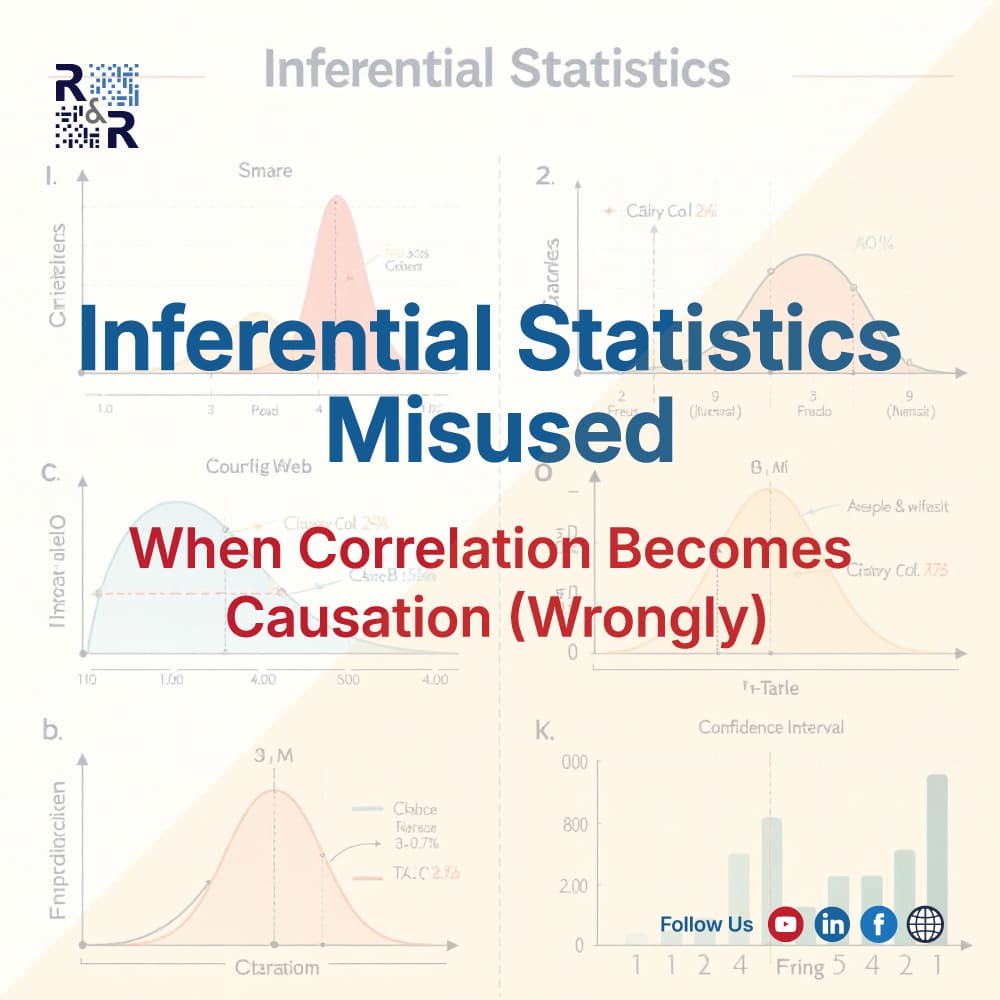Inferential statistics are powerful tools for uncovering patterns and testing relationships. But they are also easily misused. One of the most frequent and damaging mistakes we see at Research & Report Consulting is treating correlation as causation.
This statistical misstep is more than a technical flaw—it undermines credibility, damages publication chances, and can lead to misguided policy recommendations. Reviewers and journal editors catch it quickly, but many researchers fail to recognize the subtle ways it appears in their analysis.
Below, we unpack the critical issues that most researchers don’t know—but every reviewer notices.
1. Omitted Variable Bias
Two variables may appear strongly correlated, but the real driver is often a third, unobserved factor. For example, income and health outcomes correlate—but education may be the underlying driver of both. Without controlling for such confounders, causal claims collapse.
Lesson: Always check for alternative explanations through multivariate models, robustness tests, or theoretical justification.
2. Reverse Causality
Does X cause Y, or does Y cause X? Without establishing temporal order, researchers risk presenting backward causality.
Example: Studies often show a correlation between social media use and mental health problems. But does heavy social media use cause depression, or are depressed individuals more likely to use social media? Without longitudinal or instrumental-variable approaches, the answer remains unclear.
Lesson: Strong causal claims require a clear timeline or methodological tools that untangle directionality.
3. Spurious Correlations
Not all significant correlations mean anything. Some are statistical coincidences driven by unrelated but parallel trends.
Classic example: Ice cream sales and drowning incidents both rise in summer. They correlate, but ice cream doesn’t cause drowning—the real factor is temperature.
Lesson: Always check whether a correlation is theoretically meaningful, not just numerically strong.
4. Misuse of Regression Analysis
Many assume that running a regression automatically establishes causality. In reality, regression shows association under model assumptions, but causality depends on careful design and justification. Poor model specification, omitted variables, or multicollinearity often turn regressions into misleading evidence.
Lesson: Regression is a tool, not proof. Use theory and robustness checks to justify causal claims.
5. Ignoring Endogeneity
Endogeneity occurs when explanatory variables are correlated with the error term—leading to biased estimates. Common sources include omitted variables, simultaneity, and measurement errors.
Without addressing endogeneity, findings become unreliable. Techniques such as Instrumental Variables (IV), Difference-in-Differences (DiD), Propensity Score Matching (PSM), or Panel Data Models are essential to strengthen causal inference.
Lesson: Journals expect you to test and correct for endogeneity; ignoring it is a major red flag.
Why This Matters for Publication
Top journals reject manuscripts not only for weak results but for overstated causal claims. Correlation may hint at a relationship, but causation requires rigor, theory, and advanced methods. Editors expect researchers to:
- Justify causal assumptions.
- Use appropriate models and robustness checks.
- Clearly distinguish between “association” and “causation.”
Failure to do so signals a lack of methodological awareness—and results in rejection.
How Research & Report Consulting Can Help
At Research & Report Consulting, we help researchers avoid these traps by:
- Designing studies that properly separate correlation from causation.
- Applying advanced econometric tools (IV, DiD, ARDL, SEM, Panel Models).
- Strengthening theoretical justification to match statistical claims.
- Reviewing manuscripts for statistical and methodological accuracy before submission.
Our goal is not just to polish papers but to make them credible, publishable, and impactful.
Conclusion
Inferential statistics are powerful, but misusing them can sink even the strongest research. Correlation is not causation—and mistaking one for the other is among the fastest ways to face rejection.
- Check for omitted variables.
- Clarify causal direction.
- Avoid spurious correlations.
- Use regression wisely.
- Test for endogeneity.
At Research & Report Consulting, we specialize in helping researchers build methodologically sound, journal-ready manuscripts that pass reviewer scrutiny and influence real-world decisions.
Learn more at researchandreport.org
Follow us on LinkedIn & Facebook for expert insights.

